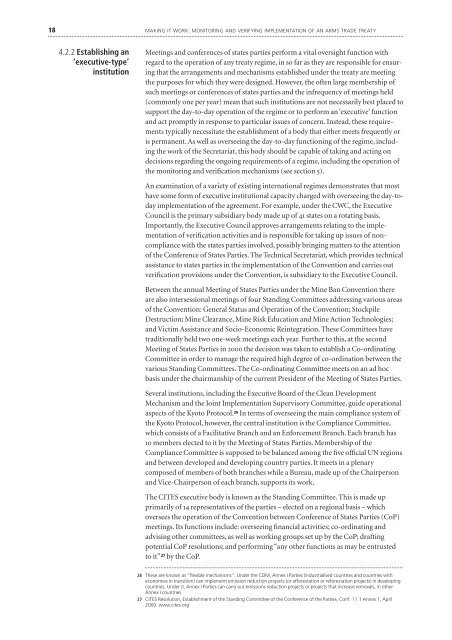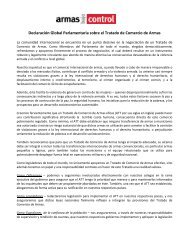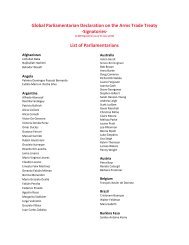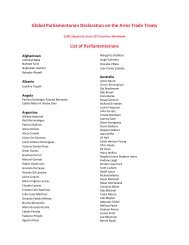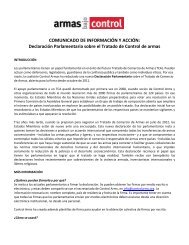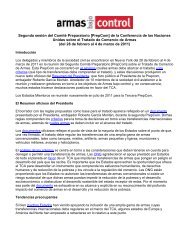Making it Work - Control Arms
Making it Work - Control Arms
Making it Work - Control Arms
- No tags were found...
You also want an ePaper? Increase the reach of your titles
YUMPU automatically turns print PDFs into web optimized ePapers that Google loves.
18 MAKING IT WORK: MONITORING AND VERIFYING IMPLEMENTATION OF AN ARMS TRADE TREATY4.2.2 Establishing an‘executive-type’inst<strong>it</strong>utionMeetings and conferences of states parties perform a v<strong>it</strong>al oversight function w<strong>it</strong>hregard to the operation of any treaty regime, in so far as they are responsible for ensuringthat the arrangements and mechanisms established under the treaty are meetingthe purposes for which they were designed. However, the often large membership ofsuch meetings or conferences of states parties and the infrequency of meetings held(commonly one per year) mean that such inst<strong>it</strong>utions are not necessarily best placed tosupport the day-to-day operation of the regime or to perform an ‘executive’ functionand act promptly in response to particular issues of concern. Instead, these requirementstypically necess<strong>it</strong>ate the establishment of a body that e<strong>it</strong>her meets frequently oris permanent. As well as overseeing the day-to-day functioning of the regime, includingthe work of the Secretariat, this body should be capable of taking and acting ondecisions regarding the ongoing requirements of a regime, including the operation ofthe mon<strong>it</strong>oring and verification mechanisms (see section 5).An examination of a variety of existing international regimes demonstrates that mosthave some form of executive inst<strong>it</strong>utional capac<strong>it</strong>y charged w<strong>it</strong>h overseeing the day-todayimplementation of the agreement. For example, under the CWC, the ExecutiveCouncil is the primary subsidiary body made up of 41 states on a rotating basis.Importantly, the Executive Council approves arrangements relating to the implementationof verification activ<strong>it</strong>ies and is responsible for taking up issues of noncompliancew<strong>it</strong>h the states parties involved, possibly bringing matters to the attentionof the Conference of States Parties. The Technical Secretariat, which provides technicalassistance to states parties in the implementation of the Convention and carries outverification provisions under the Convention, is subsidiary to the Executive Council.Between the annual Meeting of States Parties under the Mine Ban Convention thereare also intersessional meetings of four Standing Comm<strong>it</strong>tees addressing various areasof the Convention: General Status and Operation of the Convention; StockpileDestruction; Mine Clearance, Mine Risk Education and Mine Action Technologies;and Victim Assistance and Socio-Economic Reintegration. These Comm<strong>it</strong>tees havetrad<strong>it</strong>ionally held two one-week meetings each year. Further to this, at the secondMeeting of States Parties in 2000 the decision was taken to establish a Co-ordinatingComm<strong>it</strong>tee in order to manage the required high degree of co-ordination between thevarious Standing Comm<strong>it</strong>tees. The Co-ordinating Comm<strong>it</strong>tee meets on an ad hocbasis under the chairmanship of the current President of the Meeting of States Parties.Several inst<strong>it</strong>utions, including the Executive Board of the Clean DevelopmentMechanism and the Joint Implementation Supervisory Comm<strong>it</strong>tee, guide operationalaspects of the Kyoto Protocol. 26 In terms of overseeing the main compliance system ofthe Kyoto Protocol, however, the central inst<strong>it</strong>ution is the Compliance Comm<strong>it</strong>tee,which consists of a Facil<strong>it</strong>ative Branch and an Enforcement Branch. Each branch has10 members elected to <strong>it</strong> by the Meeting of States Parties. Membership of theCompliance Comm<strong>it</strong>tee is supposed to be balanced among the five official UN regionsand between developed and developing country parties. It meets in a plenarycomposed of members of both branches while a Bureau, made up of the Chairpersonand Vice-Chairperson of each branch, supports <strong>it</strong>s work.The CITES executive body is known as the Standing Comm<strong>it</strong>tee. This is made upprimarily of 14 representatives of the parties – elected on a regional basis – whichoversees the operation of the Convention between Conference of States Parties (CoP)meetings. Its functions include: overseeing financial activ<strong>it</strong>ies; co-ordinating andadvising other comm<strong>it</strong>tees, as well as working groups set up by the CoP; draftingpotential CoP resolutions; and performing “any other functions as may be entrustedto <strong>it</strong>” 27 by the CoP.26 These are known as “flexible mechanisms”: Under the CDM, Annex I Parties (industrialised countries and countries w<strong>it</strong>heconomies in trans<strong>it</strong>ion) can implement emission reduction projects (or afforestation or reforestation projects) in developingcountries. Under JI, Annex I Parties can carry out emissions reduction projects or projects that increase removals, in otherAnnex I countries.27 CITES Resolution, Establishment of the Standing Comm<strong>it</strong>tee of the Conference of the Parties, Conf. 11.1 Annex 1, April2000. www.c<strong>it</strong>es.org


